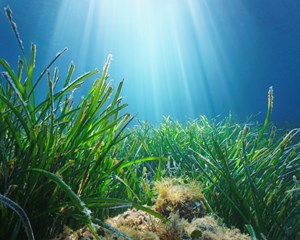- 阅读
- 阅读
- 技巧
- 百科
- 试题
- 文化
- 技能
Carbon capture and storage
碳捕获与存储技术
Supergrass
劲草
Plants in the ocean are better at storing carbon than those on land
海洋植物比陆地植物更善于储存碳
Off the coast of Formentera, an island in the Spanish Mediterranean, lives an organism that stretches 15km from one end to the other. Posidonia oceanica, more prosaically known as seagrass, spreads by sending shoots out beneath the sediment. Entire meadows, covering several hectares, can thus be made up of a single organism. The grasses are long-lived, too. The vast meadow in Formentera is thought to have been spreading for tens or hundreds of thousands of years.
西班牙地中海的福门特拉岛海岸生活着一种有机体,这种有机体从一端延伸到另一端的长度达15公里。波西多尼亚水生植物,通俗点儿讲叫海草。它通过在沉积物下发射嫩芽进行繁殖,因此就连覆盖数公顷的整片海草都是由单一有机体组成。这些草也很长寿。福门特拉广阔的海草床据悉已经蔓延了数万年甚至数十万年。
But the seagrass is more than just a biological curiosity. Along with two other kinds of coastal ecosystem—mangrove swamps and tidal marshes—seagrass meadows are particularly good at taking carbon dioxide from the air and converting it into plant matter. That makes all three ecosystems important for efforts to control climate change.
但海草不仅是一种奇特的生物。海草床,还有另外两种沿海生态系统——红树林沼泽和潮汐沼泽,尤其擅长从空气中吸收二氧化碳并将其转化为植物物质。这使得这三个生态系统对于控制气候变化都很重要。

This role was highlighted in a report published on March 2nd by UNESCO, an arm of the United Nations, on "blue carbon"—the sort captured by Earth's oceanic and coastal ecosystems. In total around 33bn tonnes of carbon dioxide (about three-quarters of the world's emissions in 2019) are locked away in the planet's bluecarbon sinks. Research by Carlos Duarte, the report's author and a marine ecologist at King Abdullah University in Saudi Arabia, has shown that one hectare of seagrass can soak up as much carbon dioxide each year as 15 hectares of rainforest.
联合国教科文组织3月2日发布的一份关于“蓝碳”(地球海洋和沿海生态系统所捕获的碳)的报告中强调了这种作用。总共约有330亿吨二氧化碳(约占2019年全球排放量的四分之三)被锁在地球的蓝碳汇中。该报告的作者、沙特阿拉伯阿卜杜拉国王大学海洋生态学家卡洛斯·杜阿尔特的研究表明,一公顷海草每年吸收的二氧化碳相当于15公顷雨林。
All this is attracting interest in blue carbon from those keen to use natural processes, rather than human technologies such as direct-air capture, to suck greenhouse gases from the atmosphere. In 2018 Apple partnered with Conservation International, a charity, to protect 11,000 hectares of mangroves on the Colombian coast. The firm estimates the project could lock away around 1m tonnes of carbon.
所有这些都吸引了那些热衷于利用自然过程而不是人类技术(如直接捕获空气)从大气中吸收温室气体的人对蓝碳的兴趣。2018年,苹果公司与慈善机构保护国际合作,保护了哥伦比亚海岸1.1万公顷的红树林。该公司估计,该项目可以储存约100万吨碳。
One reason that blue-carbon ecosystems make such effective sinks is that submerged forests are denser than their landbased equivalents. They can also trap floating debris and organic matter, which settles on the sea floor and can double the amount of carbon stored away.
蓝碳生态系统之所以会产生如此巨大的碳汇,其中一个原因是水下森林比陆上森林密度更大。它们还能捕获漂浮在海底的碎片和有机物,使碳的储存量增加一倍。
They posses another advantage, too. Unlike forests on land, blue-carbon ecosystems do not burn. Climate change is intensifying wildfires around the world. As forests burn, their carbon stocks are released back into the atmosphere. And fires can impede a forest's ability to capture carbon even after they have burned out. In a study published on February 25th in Nature Ecology and Evolution, researchers at the University of Stanford found that repeated fires favour slow-growing tree species. These are better able to survive blazes, but they are also less effective at soaking up cartbon than faster-growing species.
他们还有另一个优势。与陆地上的森林不同,蓝碳生态系统不会燃烧。气候变化正在加剧世界各地的野火。当森林燃烧时,它们的碳储存被释放回大气中。火灾会阻碍森林捕获碳的能力,即便它们已经燃烧殆尽。在2月25日发表在《自然生态与进化》杂志上的一项研究中,斯坦福大学的研究人员发现,火灾的经常爆发对生长缓慢的树种有利。它们在火灾中的存活能力更强,但它们吸收碳的效率也不如生长速度较快的物种。
Submerged forests may be impervious to fires, but they remain vulnerable to other sorts of disasters. In May 2020 cyclone Amphan destroyed 1,200 square kilometres of mangrove forest on the border between Bangladesh and the Indian state of West Bengal. A marine heatwave in Australian waters in 2010 and 2011 damaged around one third of the world's largest seagrass meadow, in Shark Bay. Over the next three years field studies showed that uprooted plants were releasing their carbon back into the atmosphere.
水下森林可能不受洪水的影响,但它们仍易受到其他灾害的影响。2020年5月,气旋“安芬”摧毁了孟加拉国和印度西孟加拉邦边境1200平方公里的红树林。2010年和2011年,澳大利亚水域的海洋热浪破坏了鲨鱼湾世界上最大的海草牧场的三分之一。实地研究表明,接下来的三年里被连根拔起的植物正在向大气中释放碳。

Fortunately, an older, man-made ecological disaster suggests that restoring damaged blue-carbon ecosystems is possible. During the Vietnam war, napalm and a cocktail of weaponised herbicides destroyed more than half of the mangroves in the Mekong delta. A report published in 2014 by the International Society for Mangrove Ecosystems showed that an intense post-war replanting programme was able to restore it within two decades.
幸运的是,一场更古早的人为生态灾难表明,受损的蓝碳生态系统的修复是可行的。越南战争期间,凝固汽油弹和武器化除草剂破坏了湄公河三角洲一半以上的红树林。国际红树林生态系统协会2014年发布的一份报告显示,战后大规模的重新种植计划能够在20年内恢复红树林。
And there is more to such ecosystems than simply acting as sponges for greenhouse gasses. They also serve as buffers for vulnerable shorelines, shielding them from storms that barrel in from the high seas. One study of 59 subtropical countries estimated that by dampening waves and providing natural barriers to storm surges, mangrove forests prevent more than $65bn in property damage each year, and help shelter more than 15 million people. Protecting and expanding them, then, appears to be a no-brainer.
这样的生态系统不仅仅能够充当温室气体的海绵。它们还可以增强脆弱的海岸线,保护它们免受来自公海的风暴的侵袭。一项针对59个亚热带国家的研究估计,红树林通过抑制海浪和为风暴潮提供天然屏障,每年可防止超过650亿美元的财产损失并为1500多万人提供了庇护。因此,保护红树林、扩大红树林的面积是无需质疑的举措。
来源:经济学人
参与评论